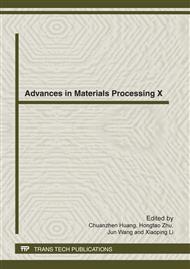p.32
p.38
p.44
p.51
p.58
p.65
p.73
p.82
p.89
Experiment Study on Cutter Disrepair Principle and Optimization for Machining Heat-Resistant Steel
Abstract:
In order to find out the cutter disrepair principle and provide a valuable reference for the design, production and use of the heavy-duty hard alloy cutter, have experiment study on machining the heat-resistant steel-the 3Cr-1Mo-1/4Vsteel. First, have impact disrepair experiments with several types of different grooves milling inserts, and find out the difference of the impact disrepair invalidation types among them, and build the impact disrepair life cumulating distribution function mathematic model. Second, based on the adhering disrepair experiments, find out the difference of the adhering disrepair invalidation types, build the quantitative mathematic relation between milling temperature and maximal adhering disrepair depth on rake face of the cutter, and analyze the rule that the milling temperature affects the adhering disrepair. And then, on the basis of the scene machining, have analysis on cutter disrepair phenomenon and mechanism under the joint action of force and heat, so to provide a theoretical basis on how to avoid premature failure of the tool for the actual production process.
Info:
Periodical:
Pages:
58-64
Citation:
Online since:
April 2012
Authors:
Price:
Сopyright:
© 2012 Trans Tech Publications Ltd. All Rights Reserved
Share:
Citation:


